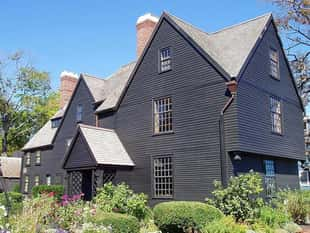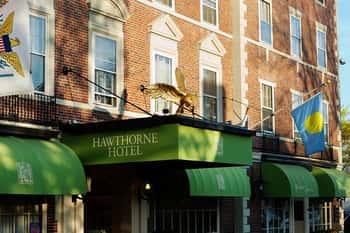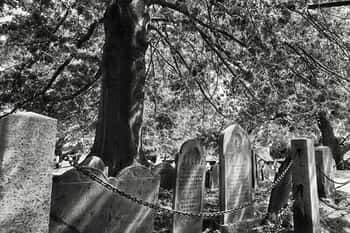Cornering the Burying Point Cemetery is a yellowed, three-storied house as gloomy as the graveyard beside it. The Grimshawe House, also known as the Peabody House, was built in 1770 at 53 Charter Street, Salem. Nathaniel Peabody purchased the house in 1835, yet the house didn’t receive its moniker until Dr. Grimshaw’e Secret, a posthumous publication of Nathaniel Hawthorne. Indeed, it was Hawthorne’s Dr. Grimshaw’e Secret, a “romance” about a spider-cultivating scientist, that saw this sinister structure to stage.
Hawthorne had even courted Peabody’s daughter Sophia in the property’s parlor, leading some to nickname the home “Hawthorne’s Courting House.” Romantic? Think again. Hawthorne had described the “old house itself” as “covering ground which else had been sown thickly with buried bodies.” The Grimshawe House, Hawthorne said, “partook of [the] dreariness” of Burying Point Cemetery – though the cemetery was “seldom disturbed” and the house “hardly worthy to be haunted.”
Still, what makes Salem’s Grimshawe House so spooky?
Purchased by Nathaniel Peabody in 1835, 53 Charter Street became known for his daughters, the Peabody Sisters.
Elizabeth, or “Lizzie,” the eldest, became an instructor, author, and experimental education advocate. Lizzie was, in fact, America’s first female publisher! She even opened the nation’s first English-language kindergarten in 1860, forefronting the dissemination of America’s pre-schools. Lizzie likewise opened Elizabeth Palmer Peabody's West Street Bookstore, where feminist Margaret Fuller’s “Conversations” were held.
Lizzie was later the business manager for transcendentalist publication The Dial; her English translation of the Buddhist Lotus Sutra, published in The Dial, was the first of its kind. With a reading knowledge of ten languages, Lizzie was a prolific, progressive pioneer. Indeed, Henry James canonized Lizzie in his Bostonians, writing that Lizzie was “heroic...sublime, the whole moral history of Boston was reflected in her displaced spectacles.”
Lizzie was, in brief, an American trailblazer. Talk about unmatched ambition!
Mary, the middle Peabody sister, became an author and teacher, later marrying education reformer Horace Mann. Horace promoted free public education, becoming known as the “Father of Common School.” Together Mary and Horace championed accessible education, actively and radically advocating education reform. Yet Mary’s involvement with early education preceded her marriage to Horace. Indeed, by the time of her marriage to Horace Mann in 1843, Mary was an experienced teacher with a repertoire of original methods, many of which featured the outdoors… She believed in individualized reading instruction for beginners, and her Primer, which employs a whole-word rather than phonetic method, reveals a philosophy of education as guided nurture.
Mary’s success didn’t stop with the death of Horace, however. In Mary’s widowhood, Mary published periodicals, translated Spanish, and assisted Lizzie with her kindergarten. And, at eighty years of age, Mary began to write her first novel, Juanita: A Romance of Real Life in Cuba Fifty Years Ago. The novel was published posthumously in 1887, extending and emphasizing the legacy of Mary Peabody.
Sophia, the youngest Peabody sister, was like Lizzie and Mary, an artist. Yet unlike Lizzie and Mary, Sophia was a painter and illustrator who only occasionally partook in print through the publication of her journals. And, unlike Lizzie and Mary, Sophia was occasionally invalid. It was assumed that her illness was due to mercury poisoning from a dental treatment prescribed by her father in Sophia’s infancy – contributing to her later exhaustion, “excitability,” anxiety, and agitation. Migraines were an additional effect of mercury poisoning, which could account for Sophia’s reliance on narcotics. Indeed, Sophia is documented to have a dependency upon calomel and opium… Yet calomel was detrimental to the nervous system. Side effects? Gangrene, gum deterioration, and loss of teeth.
It was in the Grimshawe House that Elizabeth introduced Sophia to Nathaniel Hawthorne. Elizabeth had before exclaimed that Hawthorne was “handsomer than Lord Byron!” yet Sophia had refused to meet the renowned writer. Sophia presumably denied the initial meeting due to her migraines, yet the two were nevertheless introduced. Although it’s uncertain when the introduction occurred, we know that Sophia wore a “simple white wrapper.” According to Lizzie, Hawthorne rose to look at Sophia with unmistakable intent. And, by Lizzie’s account, Sophia returned Hawthorne’s look.
Sophia had initially discouraged their marriage, citing her ill health as a preventative cause. Yet Hawthorne and Sophia were secretly engaged after a three-year courtship. Although their engagement took place on New Year’s Day of 1839, they didn’t marry until July 9, 1842. “The ceremony,” Sophia wrote to a friend, “is nothing.” To Sophia, she and Hawthorne’s “true marriage” had happened upon their betrothal.
Legend has it that the two often took midnight strolls in Burying Point Cemetery! Do their ghosts still gallivant the graveyard?
Nathaniel Hawthorne, inspired by The Grimshawe House in which he had courted his bride, included the house in his short stories. Although The Grimshaw House is featured in Hawthorne’s “The Dolliver Romance,” it was “Dr. Grimshawe’s Secret” that portrayed the house most poignantly. To Hawthorne, “The house itself, moreover, except for the convenience of its position, close to the seldom disturbed cemetery, was hardly worthy to be haunted. As I remember it (and, for aught I know, it still exists in the same guise) it did not appear to be an ancient structure, nor one that could ever have been the abode of a very wealthy or prominent family – a three-story wooden house perhaps a century old, low studded, with a square front, standing right upon the street, and a small enclosed porch, containing the main entrance affording a glimpse up and down the street through an oval window on each side, its characteristic was a decent respectability, not sinking below the boundary of the genteel.”
“Dr. Grimshawe’s Secret,” written in 1861, was only posthumously published. Yet Hawthorne’s associations with The Grimshawe House are palpable. Hawthorne, along with the Peabody sisters, helped publicize this eerie yet extraordinary structure.
For literature lovers, it’s a must-see!
Was Hawthorne wrong? Is the Grimshawe House haunted after all? It depends on who you ask. Some think that Sophia’s invalidism – along with her cemetery strolls – make her a likely “visitor.” Some even claim to have seen her apparition!
Yet in Hawthorne’s “Dr. Grimshawe’s Secret,” there was “no whisper of Doctor Grimshawe's house being haunted; a fact on which both writer and reader may congratulate themselves, the ghostly chord having been played upon in these days until it has become wearisome and nauseous as the familiar tune of a barrel-organ.” Except for “the convenience of its position close to the seldom-disturbed cemetery,” the Grimshawe House was “hardly worthy to be haunted.”
As the backdrop for Hawthorne’s spider-serum scientist, it’s certainly worth the stop.
Even if The Grimshawe House isn’t haunted, the adjacent cemetery is! Known as a site of “spiritual regeneration,” the Burying Point Cemetery is the second oldest cemetery in the United States. Notable “inhabitants” include Witch Trial Judge Hathorne and Bartholemew Gedney, fellow magistrate. Judge Hathorne had been infamously immortalized by Nathaniel Hawthorne, a descendant, who wrote that Hathorne had “made himself so conspicuous in the martyrdom of witches, that their blood may fairly be said to have left a stain on him.” Nathaniel even added a letter to his surname to distance himself from the ignominious magistrate!
Witch Trial victim Martha Corey is also buried at Burying Point, leading some to believe that she manifests as the Burying Point’s “Woman in White.” Though could this “Woman in White” be Sophia in her “simple white wrapper”?
Some visitors have even captured EVP on the premise! Others claim to see mysterious orbs or lighting otherwise unaccounted for... Indeed, many believe Burying Point Cemetery keeps company with the restless dead. It’s no surprise, though, since Burying Point was the final resting place for so many of those wrongly accused of witchcraft.
In 2019, a petition with over 4,100 signatures was created to “Save the Grimshawe House.” The petition was intended to prevent the conversion of the Grimshawe House into condominiums and ultimately preserve Salem’s historic structure. A restoration project was then proposed, saving the seventeenth-century home.
The restoration project will now return the Grimshawe House to its Federal architecture, though the owners do, however, intend to lease the second and third stories as apartments. The first story, with luck, will operate as a museum or library!
Although the Grimshawe House is closed to visitors, be sure to stop by! The spooky structure is worth a sightsee.
The Grimshawe House is also a literary monument! As the setting for Hawthorne’s “mad scientist,” it’s sure to bewitch booklovers.
While you’re there, you can also pop into the Burying Point Cemetery… If you care to keep company with the ghosts of Charter Street, that is. You can even pay your respects to those poor souls lost to Salem’s Witch Trials. Whatever you decide, let us know if you see Salem’s “Woman in White”!

One of Salem's most famous haunted houses

Spend a night in Salem's most haunted hotel

One of Salem's haunted Cemeteries